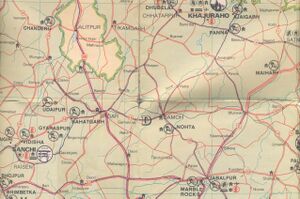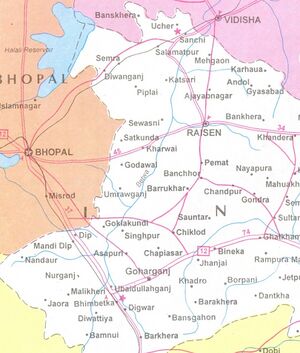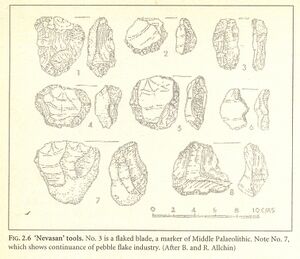Bhimbetka
| Author:Laxman Burdak, IFS (Retd.) |


Bhimbetka (भीमबेटका) is a village in Raisen tahsil in Raisen district in Madhya Pradesh.
Location
Located on Bhopal to Hoshangabad Road.
Prehistory

Irfan Habib[2] writes that...[p.26-27] Many sites in south India including Hunsgi valley in Karnataka, and Attirampakkam, near Chennai, have turned up “Early Acheulean tools” (of the so - called 'Madras industry'), that is, hand axes, etc., made mainly from the cores (see Fig. 2.5).

The U-Th method has yielded dates going back to beyond 350,000 years for sites in Karnataka. Lower Palaeolithic artefacts at Didwana in Rajasthan have been dated by the same means to 390,000 years ago, and at Nevasa in Ahmadnagar district of Maharashtra to 350,000 years ago.
During this process of his diffusion there was a tendency over time for the original Homo erectus to evolve into sub-species that were less robust but more dexterous, and so could make smaller tools out of flakes or the 'Late Acheulean tools'. Remains of such tools have been found in the Narmada valley, where these appear in association with the 'Narmada skull' discovered at Hathnora. This skull, belonging to an evolved Homo erectus could date back to a time earlier than 130,000 years ago. At the famous cave of Bhimbetka in the same area, successive periods of occupation begin with the lowest floors containing Late Acheulean tools.
As Homo erectus evolved, he also improved his tools, giving them new shapes and adjusting the technique to locally available materials. Such changes occurred very slowly, over tens of thousands of years, but these ultimately led to the rise of regional 'cultures'. The term 'culture' is used when archaeologists find at a layer in one or more sites a similar assemblage of tools, ornaments and other products of human labour, which they call 'artefacts', as well as indications of similar customs and beliefs, such as systems of disposing of the dead, and ritual symbols. Regarding Homo erectus, there is little known of custom or belief, and the forms of his stone tools alone supply us with clues to his varied cultures. As the millennia passed, the tendency was for the production of smaller and thinner tools; and the apparently independent appearances of the flake blade in many parts of the world were a natural result of such a tendency. The flake blade is supposed to mark the Middle Palaeolithic stage in India. Such stone blades are found in the 'Nevasa culture' (named after the site of Nevasa already mentioned), which seems to have extended over the southern peninsula and central India (see Fig. 2.6).

At Didwana, the Middle Paeolithic is dated by the TL method to about 150.000 years, ago, but in Gujarat a date as late as 56,800 years ago has been obtained by the U-Th method. In Sri Lanka's southern wet zone, a range of 200,000 to 40,000 years ago has been suggested for it. So the culture may have lasted for a hundred thousand years, if not more. This culture is held to be in direct continuity with the Lower Palaeolithic; and, therefore, its authors were probably the direct descendants of the late Homo erectus, though no skeletal remains have yet been found at any of the sites.
History
Dickinsonia, one of the rarest fossils in the world, has been discovered in Madhya Pradesh's Bhimbetka rock shelters, about 40 kms away from the city of Bhopal. Dickinsonia is an extinct genus of a basal animal that lived during the late Ediacaran period.
Dickinsonia is an extinct genus of basal animal that lived during the late Ediacaran period in what is now Australia, Russia and Ukraine. The individual Dickinsonia typically resembles a bilaterally symmetrical ribbed oval. The fossils are known only in the form of imprints and casts in sandstone beds.
Researchers believe they have found Dickinsonia that dates back 570 million years on the roof of the 'Auditorium Cave' at Bhimbetka.
Dickinsonia fossils found in other parts of the world exceeded 4 feet in length. But the one found in Bhimbetka is 17 inches long, reported The Times of India.
The fossil was hidden in plain sight and was discovered by chance when two experts from the Geological Survey of India (GSI) were exploring Bhimbetka ahead of the 36th International Geological Congress. The experts spotted the leaf-like impression 11-feet above the ground. As it was almost blending with the rock, it could've been easily mistaken for pre-historic rock art, said the experts.
The February edition of Gondwana Research, an international journal, has published the study by the researchers.
"The fossils were found in the roof of Auditorium Cave at Bhimbetka Rock Shelters, a UNESCO World Heritage site for Paleolithic and Mesolithic cave art, near Bhopal. They are identical with Dickinsonia tenuis from the Ediacara Member of the Rawnsley Quartzite in South Australia," says an abstract from the paper.
The experts were able to find imprints of the fossil, which are usually preserved as negative impressions on the bases of sandstone beds. The first specimens of the fossil was discovered in the Ediacaran Member of Rawnsley Quartzite, Flinders Rangers in South Australia.
The Bhimbetka rock shelters were found by VS Wakankar 64 years ago. Since then, many researchers have visited the site. However, the dickinsonia fossil remained undetected.
Reference - www.timesnownews.com 10.2.2021
Notable persons
Population
See also
External links
References
- ↑ People’s History of India 1, Prehistory, by Irfan Habib, Aligarh Historians Society, Published by Tulika Books, Second Edition, 2002, ISBN: 81-85229-68-6,p.30-31
- ↑ People’s History of India 1, Prehistory, by Irfan Habib, Aligarh Historians Society, Published by Tulika Books, Second Edition, 2002, ISBN: 81-85229-68-6,p.26-27

